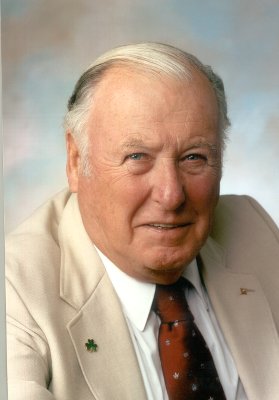James W. Cooley: Difference between revisions
(Created page with "== Biography == In 1965, Drs. James W. Cooley and John W. Tukey (IEEE 1982 Medal of Honor recipient) published a paper describing the Fast Fourier Transform (FFT) algorithm, wh...") |
No edit summary |
||
| Line 1: | Line 1: | ||
== Biography == | == Biography == | ||
In 1965, Drs. James W. Cooley and John W. Tukey (IEEE 1982 Medal of Honor recipient) published a paper describing the Fast Fourier Transform (FFT) algorithm, which led to an explosion in digital signal processing. Their landmark research offered enormous improvements in processing speeds and played an essential role in the digital revolution. Today, digital signal processing is an integral part of communications, information processing, consumer electronics, control systems, radar and sonar, medical diagnosis, seismology, scientific instrumentation and more. | [[Image:James W. Cooley 3529.jpg|thumb|right]] | ||
In 1965, Drs. James W. Cooley and [[John Tukey|John W. Tukey]] (IEEE 1982 [[IEEE Medal of Honor|Medal of Honor]] recipient) published a paper describing the Fast Fourier Transform (FFT) algorithm, which led to an explosion in digital signal processing. Their landmark research offered enormous improvements in processing speeds and played an essential role in the digital revolution. Today, digital signal processing is an integral part of communications, information processing, consumer electronics, control systems, radar and sonar, medical diagnosis, seismology, scientific instrumentation and more. | |||
Following the paper’s publication, Dr. Cooley determined to help others understand the algorithm and its use. While at the IBM Watson Research Center in Yorktown Heights, N.Y, he made countless contributions to the promotion of the FFT, including serving for many years on the Digital Signal Processing Committee of the IEEE Acoustics, Speech, and Signal Processing Society (now the IEEE Signal Processing Society). His IEEE Arden House Workshops also laid the groundwork for the IEEE Signal Processing Society. | Following the paper’s publication, Dr. Cooley determined to help others understand the algorithm and its use. While at the IBM Watson Research Center in Yorktown Heights, N.Y, he made countless contributions to the promotion of the FFT, including serving for many years on the Digital Signal Processing Committee of the IEEE Acoustics, Speech, and Signal Processing Society (now the IEEE Signal Processing Society). His IEEE Arden House Workshops also laid the groundwork for the IEEE Signal Processing Society. | ||
| Line 7: | Line 9: | ||
After his retirement from IBM in 1991, he joined the Electrical Engineering Department at the University of Rhode Island. Today he serves URI as an adjunct and continues to participate in research projects in signal detection. | After his retirement from IBM in 1991, he joined the Electrical Engineering Department at the University of Rhode Island. Today he serves URI as an adjunct and continues to participate in research projects in signal detection. | ||
An IEEE Fellow and a member of the National Academy of Engineering, Dr. Cooley received several IEEE Society awards and an IEEE Centennial medal. | An [[IEEE Fellow Grade History|IEEE Fellow]] and a member of the National Academy of Engineering, Dr. Cooley received several IEEE Society awards and an IEEE Centennial medal. | ||
== Further Reading == | |||
[[Oral-History:James W. Cooley|James W. Cooley Oral History]] | |||
[[ | [[Archives:History of FFT with Cooley and Tukey|History of FFT with Cooley and Tukey]] | ||
[[Category:Signal_processing]] | [[Category:Signal_processing]] | ||
[[Category:Digital_signal_processing]] | [[Category:Digital_signal_processing]] | ||
Revision as of 19:00, 31 August 2011
Biography
In 1965, Drs. James W. Cooley and John W. Tukey (IEEE 1982 Medal of Honor recipient) published a paper describing the Fast Fourier Transform (FFT) algorithm, which led to an explosion in digital signal processing. Their landmark research offered enormous improvements in processing speeds and played an essential role in the digital revolution. Today, digital signal processing is an integral part of communications, information processing, consumer electronics, control systems, radar and sonar, medical diagnosis, seismology, scientific instrumentation and more.
Following the paper’s publication, Dr. Cooley determined to help others understand the algorithm and its use. While at the IBM Watson Research Center in Yorktown Heights, N.Y, he made countless contributions to the promotion of the FFT, including serving for many years on the Digital Signal Processing Committee of the IEEE Acoustics, Speech, and Signal Processing Society (now the IEEE Signal Processing Society). His IEEE Arden House Workshops also laid the groundwork for the IEEE Signal Processing Society.
After his retirement from IBM in 1991, he joined the Electrical Engineering Department at the University of Rhode Island. Today he serves URI as an adjunct and continues to participate in research projects in signal detection.
An IEEE Fellow and a member of the National Academy of Engineering, Dr. Cooley received several IEEE Society awards and an IEEE Centennial medal.
